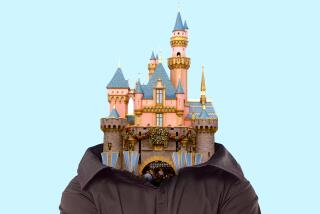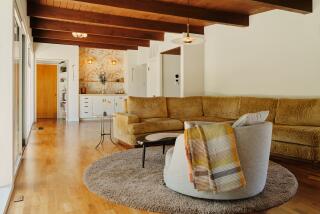N.J. Town Gambles on the ‘50s to Boost the ‘90s
- Share via
WILDWOOD, N.J. — On warm summer nights, the edge of the land glows with a neon exuberance that seems oddly out of time--beacons of an America full of families with money in their pockets, tail-fin cars in their driveways and their best days just down the road.
Each season, the moteliers of the Wildwoods switch on their iridescent marquees, and the signs over 13,000 rooms come wildly alive: Caribbean and Lollipop. Satellite and Bel Air and Ebb Tide. Aquarius and Ala Moana and Grecian Gardens. Then come the beach-goers, seeking their annual few days in an exotic place that echoes other, even more exotic, places.
Today in the Wildwoods, a barrier island on the South Jersey Shore, the feel of the 1950s endures in architecture if not in spirit. But its summer is too short a season.
Many of the island’s bread-and-butter vacationers from Philadelphia have found more upscale towns; others simply perceive Wildwood as a day’s diversion rather than a place to stay. Still others think it has become a bit too wild for family fun.
So the town’s entrepreneurs, with help from architecture students from three universities, have come up with a plan: Pump up the volume. Paint with the palette of Pez. Let plastic palms proliferate. Make the ‘50s--”Doo-Wop architecture,” they’ve dubbed it--the official theme of the place.
This is a tale about place and what it means, about how nostalgia for the 1950s and 1960s is being used as an advertisement, a way to take a commercial “feel” that developed organically and augment it with the artificially conceived.
Will the Wildwoods, as a place, become a better version of itself or yet another theme park--packaged, processed and performed like a play? Is there a difference?
“We’re giving our towns some medicine,” says Jack Morey, a founder of the Doo-Wop Preservation League, which is leading the effort from its neon-festooned downtown headquarters. “The risk is that you gentrify something to the point where you destroy its heritage. But if you don’t gentrify at all, you die.”
For years, Wildwood--visitors’ collective term for the communities of Wildwood, North Wildwood and Wildwood Crest--has been an expanding world of gargantuan commercial messages, mom-and-pop ingenuity and shore-town aesthetics, brought to life in bright oranges, sunshine yellows, eye-popping pinks and tropical aquamarines.
In 1900, Philadelphia’s manufacturing revolution was doubling its workers’ salaries and giving them something new: vacation time. They streamed toward the water--and Wildwood.
“They created a world of vacation and mass experience, the world out of which this town comes,” says George E. Thomas, a historian of the Jersey Shore.
With the help of Morey’s father, Wilbert, who built Wildwood’s seaside amusement parks and opened motels that pushed the architecture to fantasy proportions, the island became a blend of beach and gaudy boardwalk--a penny-candy Atlantic City of Skee-Ball machines and pizza slices.
But the baby boomers grew up and had fewer kids than their parents. The motels and boardwalk aged, and communities like Stone Harbor and Avalon to the north became fashionable. Though the Wildwoods still attracted legions of stalwarts, their entrepreneurial glee began to be a curiosity--and a rumpus room for graduating high-school seniors.
Add some boarded-up storefronts downtown, some nagging unemployment and the ebbing of Philadelphia’s industrial economy, and the Wildwoods were understandably seeking new ways to extend the season and attract newcomers.
“We do need help here,” acknowledges Maryann Hartlein of Wildwood Crest. She and her husband, Bill, operate the Casa Bahama Motel, rich with dramatic A-frames and plastic palms.
Enter the Doo-Wop revival, which started in the 1970s with “Happy Days” and “American Graffiti,” gained momentum throughout the 1980s with theme restaurants and oldies stations and still thrives: The movie “Grease” was re-released this spring to wide fanfare. Virtually anything from that era sells.
“The motels in the Wildwoods are icons of the century. And nostalgia is good business,” says Alex Shear, who runs Nostalgia Brokers in New York City.
He spoke earlier this month at the preservation league, where architecture students from Penn State, Yale and Kent State presented their six-month study of how to make Wildwood more Wildwoodian.
Some conclusions: Build a Doo-Wop-style sports center. Combine smaller motels into super-motels with even brighter colors and louder architecture. Organize a 1950s film festival. And take those decades-old signs from boarded-up businesses to the center of town for a street-corner signage museum.
“The message is, ‘Please don’t make it too tasteful.’ We don’t want a backlit Holiday Inn,” says Steven Izenour, a Philadelphia architect who advised the students. “The American commercial vernacular has produced some very beautiful items. Our role is popularizers on one level--to say, ‘Hey, everything you take for granted here is great. But tweak this 10% and you’ve really got something.’ ”
Their models are the revival of Florida’s art deco South Beach, California’s Santa Monica and especially Cape May, another Jersey Shore town six miles south. Lined with Victorian houses, Cape May is one of the region’s biggest draws and a national architectural attraction.
It wasn’t always seen as tasteful, though.
“Victorian Cape May was kitsch 20 years ago,” says Thomas, the historian. “These towns are the places where the culture plays out, where it reveals what’s next.”
But in today’s world, where conglomerates like Disney take an empty field and erect a synthesis of town, amusement park, theme hotel and entertainment center, there is another issue: Will premeditated Doo-Woppery make the Wildwoods less real?
Although some warn about taking on too much too soon, few show reservations.
“I frequently think of the Wildwoods as a giant real-life theme park,” says Morey, who helps run the theme parks his father built. “But we don’t want there to be too much control. We want it to be edgy without being risky.”
Adds Izenour: “We’re not denying the Disney sort of make-believe . . . the elements of play-acting and stage-setting. Inauthentic? Yes, you need to think about that. The newest is always the most inauthentic. But let it age awhile and it becomes authentic. The measure of authenticity is time.”
Developers and motel owners are excited too. “We’re poised for success,” says Lester Katsanis of the Quebec Motel. And down at Schellenger’s Restaurant, owner Tony Trivelis is remodeling to add bright colors, a 35-foot rooftop lighthouse, a backlit boat and myriad fake fish.
“People are going to themes. They like to see attractions,” he says. “People will see we’re successful. And they’ll say, ‘If he can do it, why can’t we?’ ”
Newcomer Peter Ferriero, too, has joined the effort. He bought the old Georgeanna Motel this year and has spent a month and $125,000 changing it into the Memory Motel, which will feature a movie-and-music motif. Each guest room will feature a star, and old movies will show on a giant-screen TV in the lobby by the pool.
Oh--and the architecture will be loud, beckoning and larger than life. In other words, a perfect fit for the Wildwoods’ plan for its tomorrow--built by a guy who came here as a kid.
“I always remembered the signs--how big they were, how they glowed,” he says. “I said to myself, ‘Let me go back there and theme it.’ I’ve always loved Wildwood. And now me and my business are going to be part of its future.”
More to Read
Sign up for The Wild
We’ll help you find the best places to hike, bike and run, as well as the perfect silent spots for meditation and yoga.
You may occasionally receive promotional content from the Los Angeles Times.






